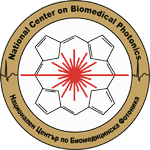Scientific capacity
Description and activities of the infrastructure:
The strategic goal of the NCBMP is the institutionalization and development of the scientific field “Biophotonics, bionanophotonics” as a part of the national and European scientific infrastructure.
Main activities are aimed at:
Creating conditions for conducting basic research to acquire new knowledge about the optical, biochemical and functional properties of biological matter; scientific and applied research for the creation of medical diagnostic and therapeutic methods and research for the development of the methodological and instrumental basis of medical theranostics and personalization of medical practice;
Development of prototypes, demonstrations, pilot projects, testing and validation of new or improved products, processes or services in a representative environment for the real operating conditions.
The main tasks of NCBMP are:
- Research in the field of tissue optics and spectroscopy of biological objects for development of diagnostic and analytical methods, laser micro- and nano-treatment of biological tissues for application in medical therapy. Micro / nanolithographic structuring for the development of nanoscale sensors.
- Investigation of the relationship between changes in the (epi) genome and (epi) transcriptome from embryonic development to adulthood with changes in immunity and the development of pathology in humans (and animals), in order to improve quality of life.
- Research of photoinduced processes in micro- and nanoscale layers and structures, development of high-tech materials, methods and technologies for optical applications, creation of new materials and recording systems with application in biophotonics and sensors.
- Development of methods for early diagnosis of tumor diseases, as well as for monitoring the effectiveness of therapeutic treatment. Screening technology for diagnosis and monitoring of a wide range of diseases; electroporation, electrofusion, electrotransformation, electrotransmission of macromolecules across membranes, electrochemotherapy of tumors.
- Development of multimodal nanoparticles capable of delivering and subsequently releasing drugs into target tissues. Development of new optically active materials, new coatings with improved biocompatibility and biodegradability and new technologies for targeting drug agents to tumor cells.
- Development of new photonic and nano-technological medical approaches and products for improving health and longevity in all areas of Nanomedicine identified in ISIS: nanodiagnostics, nanopharmacology, nanoregenerative medicine, nanotherapy, nanosurgery.
- Development of new laser methods, medical devices and methods such as “optical biopsy” and development of a new medical field – “photodynamic / sonodynamic medicine”.
- Complex development of the “Theranostic nanomedicine” approach, for “delivering the right medicine for a specific patient at the right time in the right place in the body”, especially in the treatment of cancer.
Impact / benefits:
The obtained results will have an impact on: creation of a new generation of biovalidating models of tumor and other pathologies that mimic living human or animal tissue and allow complex testing of the effects of various physical / chemical factors based on methods of biological impact at the level of genetic material; its functional state, cell physiology, tissue functions. These results will affect the fields of biomedicine, pharmacy, clinical medicine, in its most modern areas – theranostics, photodynamic medicine, nanomedicine.Potential users are the scientific community, the biopharmaceutical industry, clinical practice, related sciences – veterinary medicine, biology, chemistry.
